Abstract
This paper represents a personal view of the state of HCI as a design discipline and as a scientific discipline,
and how this is changing in the face of new technological and social situations. Going back 20 years
a frequent topic of discussion was whether HCI was a 'discipline'. It is unclear whether this was ever a
fruitful topic, but academic disciplines are effectively about academic communities and there is ample
evidence of the long-term stability of the international HCI/CHI community. However, as in computer
'science', the central scientific core of HCI is perhaps still unclear; for example, a strength of HCI is the
closeness between theory and practice, but the corresponding danger is that the two are often confused.
The paper focuses particularly on the challenge of methodological thinking in HCI, especially as the technological
and social context of HCI rapidly changes. This is set alongside two other challenges: the development
of reliable knowledge in HCI and the clear understanding of interlinked human roles within the
discipline. As a case study of the need for methodological thinking, the paper considers the use of single
person studies in research and design. These are likely to be particularly valuable as we move from a
small number of applications used by many people to a 'long tail' where large numbers of applications
are used by small numbers of people. This change calls for different practical design strategies; focusing
on the peak experience of a few rather than acceptable performance for many. Moving back to the
broader picture, as we see more diversity both in terms of types of systems and kinds of concerns, this
may also be an opportunity to reflect on what is core across these; potential fragmentation becoming
a locus to understand more clearly what defines HCI, not just for the things we see now, but for the future
that we cannot see.
keywords: HCI discipline, Methodology, Theory, Peak experience, Single person study
Acknowledgements
Many thanks to Aaron Quigley, Gavin Doherty and Liam Bannon for inviting me to share in the inaugural celebration of SIGCHI Ireland on which this paper was based; and to everyone who attended the presentation and chatted after and before that talk. Special thanks also to Fariza Razak whose work I have referred to extensively, to Matt Oppenheim (alias hardware monkey) for his wonderful cartoons of the computer breaking free, and to Fiona Dix for proofreading. Thanks also to the critical insights of the anonymous reviewers of this paper and to the special issue editors.
References
- A. Dix, Human-Computer Interaction in the Early 21st Century: a Stable Discipline, a Nascent Science, and the Growth of the Long Tail, SIGCHI Ireland Inaugural Lecture, Trinity College Dublin, 2nd December 2008. http://www.hcibook.com/alan/talks/Dublin-2008/
- A. Blandford, HCI Research and Quality: Discussion Document. UCLIC/Equator two-day workshop on The Future of HCI in the UK: Research and Careers, (Loughborough University, 14-15th June, 2007). http://www.uclic.ucl.ac.uk/projects/future-uk-hci/
- A. Dix, Theoretical analysis and theory creation, Chapter 9 in: P. Cairns, A. Cox (Eds.), Research Methods for Human-Computer Interaction, Cambridge University Press, 2008.
- Y. Rogers, New Theoretical Approaches For HCI, Annual Review of Information Science and Technology, 38 (2004).
- B. Shackel, Ergonomics for a computer, Design 120 (1959) 36-39.
- J. Long, J. Dowell, Conceptions of the discipline of HCI: craft, applied science, and engineering, in: A. Sutcliffe and L. Macaulay (Eds.), Proceedings of the Fifth Conference of the British Computer Society, Human-Computer interaction Specialist Group on People and Computers V (Univ. of Nottingham), Cambridge University Press, New York, 1989, pp. 9-32.
- R. Harper, T. Rodden, Y. Rogers, A. Sellen, Being Human: Human-Computer Interaction in the Year 2020. Microsoft Research, Cambridge, 2008. http://research.microsoft.com/en-us/um/cambridge/projects/hci2020/
- J. Long, Specifying relations between research and the design of human-computer interactions, Int . J . Human-Computer Studies, 44 (1996) 875-920
- D. Diaper, The discipline of human-computer interaction. Interacting with Computers, 1, 1 (1989) 3-5.
- D. Diaper, C. Sanger, Tasks for and tasks in human-computer interaction. Interacting with Computers, 18, 1 (Jan. 2006) 117-138, DOI: http://dx.doi.org/10.1016/j.intcom.2005.06.004
- J. McCarthy, P. Wright, Technology as Experience, MIT Press, Cambridge, 2004.
- A. Dix, S. Gill, D. Ramduny-Ellis, J. Hare, Design and Physicality - Towards an understanding of physicality in design and use, in: Designing for the 21st Century: Interdisciplinary Methods & Findings. Gower, 2009.
- R. Dawkins, Chapter 11, Memes:the new replicators. in: The Selfish Gene, Oxford University Press, London, 1976
- H. Clark, S. Brennan, Grounding in communication, in: L. Resnick, J. Levine, S. Teasley (Eds.), Perspectives on Socially Shared Cognition, American Psychological Association, Washington, 1991, pp. 127-149.
- H. Clark, Using Language. Cambridge University Press, Cambridge, 1996.
- S. Star, The structure of ill-structured solutions: boundary objects and heterogeneous distributed problem solving, in: L. Gasser, M. Huhns (Eds.), Distributed Artificial Intelligence, Volume II, Morgan Kaufmann, SF Mateo, 1989, pp. 37-54.
- A. Dix, J. Finlay, G. Abowd, R. Beale, Interaction design basics, Chapter 5 in: Human-Computer Interaction, third edition. Prentice Hall, 2004
- S. Brand, How Buildings Learn: What Happens After They're Built, Viking Press, 1994.
- J. Nielsen, Why You Only Need to Test With 5 Users, Alertbox, March 19, 2000. http:// www.useit.com/alertbox/20000319.html
- G. Miller, The Magical Number Seven, Plus or Minus Two: Some Limits on Our Capacity for Processing Information, The Psychological Review, 63 (1956) pp. 81-97. http://www.musanim.com/miller1956/
- J. Nielsen, T. Landauer, A mathematical model of the finding of usability problems, in: Proceedings of the INTERACT '93 and CHI '93 Conference on Human Factors in Computing Systems (Amsterdam, The Netherlands, April 24 - 29, 1993). ACM Press, New York, 1993, pp. 206-213. http://doi.acm.org/10.1145/169059.169166
- K. Larson, M. Czerwinski, M.. Web Page Design: Implications of Memory, Structure and Scent for Information Retrieval, in: Proceedings of CHI98, Human Factors in Computing Systems, ACM Press, 1998, pp. 25-32.
- A. Dix, Upside down As and algorithms - computational formalisms and theory, Chapter 14 in: J. Carroll (Ed.), HCI Models, Theories, and Frameworks: Toward a Mulitdisciplinary Science, Morgan Kaufmann, San Francisco, 2003, pp. 381-429. http://www.hcibook.com/alan/papers/theory-formal-2003
- J-F. Rouet, C. Ros, G. Jégou, S. Metta, Locating relevant categories in web menus: effects of menu structure, aging and task complexity, in: D. Harris, V. Duffy, M. Smith, C. Stephandis (Eds.), Human-Centred Computing: Cognitive Social and Ergonomic Aspects. Vol. 3 of Proc. of HCI Intnl Laurence Earlbaum, New Jersey, 2003, pp. 547-551.
- B. Eisenberg, Debunking Miller's Magic 7. ClickZ, Oct 29, 2004. http://www.clickz.com/3427631
- A. Dix, Controversy and Provocation. In Proceedings of HCIE2004, The 7th Educators Workshop: Effective Teaching and Training in HCI, (Preston, UK 1st and 2nd April 2004). ISBN 0-9541927-5-3 http://www.hcibook.com/alan/papers/HCIE2004/
- A. Dix, European HCI Theory - a uniquely disparate perspective, European HCI Research special area CHI 2004, Vienna, Austria, 24-29 April 2004. http://www.hcibook.com/alan/papers/chi2004-euro-theory/
- A. Dix, Teaching Innovation, in: Excellence in Education and Training convention, Singapore Polytechnic, 17th May 2002. http://www.hcibook.com/alan/talks/singapore2002/
- G. Ellis, A. Dix, An explorative analysis of user evaluation studies in information visualisation, in: Proceedings of the 2006 Conference on Beyond Time and Errors: Novel Evaluation Methods For information Visualization (Venice, Italy, May 23 - 23, 2006), BELIV '06, ACM Press, New York, 2006, pp. 1-7. http://www.hcibook.com/alan/papers/beliv06-evaluation/
- D. Furniss, A. Blandford, P. Curzon, Usability evaluation methods in practice: understanding the context in which they are embedded, in: Proceedings of the 14th European Conference on Cognitive Ergonomics: Invent! Explore! (London, August 28-31, 2007). ECCE '07, vol. 250. ACM Press, New York, 2007, pp. 253-256. DOI: http://doi.acm.org/10.1145/1362550.1362602
- A. Blandford, J. Hyde, T. Green, I. Connell, Scoping analytical usability evaluation methods: a case study, Human-Computer Interaction, 23 (2008) 278-327. DOI: 10.1080/07370020802278254
- K. Popper, The Logic of Scientific Discovery, Basic Books, New York, 1959.
- J. Johnson, T. Roberts, W. Verplank, D. Smith, C. Irby, M. Beard, K. Mackey, The Xerox Star: A Retrospective, Computer, 22, 9 (Sep. 1989) 11-26, 28-29. http://dx.doi.org/10.1109/2.35211
- A. Dix, Hands Across the Screen - why scrollbars are on the right and other stories, Interfaces, 37 (Spring 1998) 19-22,
http://www.hcibook.com/alan/papers/scrollbar/
- A. Dix, Sinister Scrollbar in the Xerox Star Xplained. Interfaces, 38 (Summer 1998) 11, (short update to the above article), http://www.hcibook.com/alan/papers/scrollbar/scrollbar2.html
- P. Cairns, HCI... not as it should be: inferential statistics in HCI research, in: L. Ball, M. Sasse, C. Sas, et al (Eds.), Proc. of HCI 2007, Vol 1 BCS, 2007, pp. 195-201
- P. Dourish, Implications for design, in: R. Grinter, T. Rodden, P. Aoki, E. Cutrell, R. Jeffries, G. Olson (Eds.), Proceedings of CHI'06, the SIGCHI Conference on Human Factors in Computing Systems (Montréal, Québec, Canada, April 22 - 27, 2006), ACM Press, New York, 2006, pp. 541-550. DOI:10.1145/1124772.1124855
- J. Long, Theory in Human-Computer Interaction? in: IEE colloquium on Theory in Human-Computer Interaction (HCI), IEE, London, (Digest No.192), 17 Dec 1991, pp. 2/1-2/6. http://ieeexplore.ieee.org/stamp/stamp.jsp?arnumber=241136&isnumber=6182
- A. Sutcliffe, On the effective use and reuse of HCI knowledge, ACM Trans. Comput.-Hum. Interact. 7, 2 (Jun. 2000), 197-221. DOI= http://doi.acm.org/10.1145/353485.353488
- J. Tidwell, Common Ground: a pattern language for human-computer interface design, dated 1999, accessed May 2009. http://www.mit.edu/~jtidwell/interaction_patterns.html
- J. Tidwell, Designing Interfaces: Patterns for Effective Interaction Design, O'Reilly, 2005.
- M. van Welie, Welie.com: Patterns in Interaction Design, dated 2008, accessed May 2009. http://www.welie.com/
- W. Buxton, Less is More (More or Less), in: P. Denning (Ed.), The Invisible Future: The seamless integration of technology in everyday life, McGraw Hill, New York, 2001, pp. 145-179.
- A. Dix, PopuNET: pervasive, permanent access to the Internet, eBulletin, aQtive ltd., July 1998. http://www.hiraeth.com/alan/ebulletin/PopuNET/PopuNET.html
- L. White, Medieval Technology and Social Change, Oxford University Press, 1968
- M. De Certeau, The Practice of Everyday Life, trans. S. Rendall, University of California Press, Berkeley, 1984. original French: L'invention du Quotidien. Vol. 1, Arts de Faire', 1980.
- T. O'Reilly, What Is Web 2.0: Design Patterns and Business Models for the Next Generation of Software, O'Reilly Media, 30th Sept. 2005, (accessed 23/06/2007) http://www.oreillynet.com/pub/a/oreilly/tim/news/2005/09/30/what-is-web-20.html
- A. Dix, The Web Sharer Vision, eBulletin, aQtive ltd., November 1999. http://www.hiraeth.com/alan/ebulletin/websharer/
- F. Razak, Single Person Study: Methodological Issues, PhD Thesis. Computing Department, Lancaster University, UK, February 2008. http://www.hcibook.net/people/Fariza/
- J. Djajadiningrat, W. Gaver, J. Frens, Interaction relabelling and extreme characters: Methods for exploring aesthetic interactions, in: D. Boyarski, W. Kellogg, (Eds.), Proceedings of DIS2000 Designing Interactive Systems: Processes, Practices Methods and Techniques (New York 17-19 August 2000), ACM Press, New York, 2000, pp. 66-71.
- A. Dix, T. Ormerod, M. Twidale, C. Sas, P. Gomes da Silva, L. McKnight, Why bad ideas are a good idea. in: Proceedings of HCIEd.2006-1 Inventivity, Ballina/Killaloe, Ireland, 23-24 March 2006.
http://www.hcibook.com/alan/papers/HCIed2006-badideas/
- M. Merleau-Ponty, M. Phénomènologie de la Perception, Gallimard, Paris, 1945. (quote in text from: M. Merleau-Ponty, Phenomenology of Perception, K. Paul (trans.), Routledge, 1962, 2002)
- m. c. schraefel, A. Dix, Within bounds and between domains: reflecting on making tea within the context of design elicitation methods, International Journal of Human-Computer Studies, 67, 4 (April 2009) 313-323.
- H. Garfinkel, Studies in Ethnomethodology. Prentice- Hall, Englewood Cliffs, 1967.
- L. Gamberini, A. Spagnolli, P. Pretto, Temporal structure of SMS-mediated conversation. in: Time Design Workshop, CHI2004, Wien, April 25, 2004.
- A. Spagnolli, L. Gamberini, Interacting via SMS: practises of social closeness and reciprocation, British Journal of Social Psychology 22 (2007) 343-364.
- A. Battro, Half a Brain is Enough: The Story of Nico. Cambridge Studies in Cognitive and Perceptual Development (No. 5), Cambridge University Press, 2001.
- A. Damasio, Descartes' Error: Emotion, Reason, and the Human Brain, Putnam Publishing, 1994 (paperback: Penguin, 2005)
- P. Marty, M. Twidale, Lost in gallery space: A conceptual framework for analyzing the usability flaws of museum Web sites, First Monday, 9, 9 (2004).
- P. Marty, M. Twidale, Extreme Discount Usability Engineering, Technical Report ISRN UIUCLIS--2005/1+CSCW.
- P. Marty, M. Twidale, Usability@90mph: Presenting and Evaluating a New, High-Speed Method for Demonstrating User Testing in Front of an Audience, First Monday, 10, 7 (July 2005).
- J. Sykes, presentation at panel on "Funology: A Science of Enjoyable Technology?", M. Blyth (chair), ECCE-12, (St Williams College, Yor, 12-15 Sept. 2004)
- PHP Manual: A History of PHP, accessed 1st May 2009. http://gtk.php.net/manual1/en/html/intro.whatis.php.history.html
- P. Silva, A. Dix, Usability - Not as we know it! in: Proceedings of BCS HCI 2007, People and Computers XXI, BCS eWiC. 2007. http://www.hcibook.com/alan/papers/HCI2007-YouTube/
- G. Button, P. Dourish, Technomethodology: paradoxes and possibilities, in: M. Tauber (Ed.). Proceedings of CHI '96, The SIGCHI Conference on Human Factors in Computing Systems: Common Ground (Vancouver, British Columbia, Canada, April 13 - 18, 1996). ACM, New York, NY, 19-26. DOI= http://doi.acm.org/10.1145/238386.238394
- W. Gaver, Cultural commentators: Non-native interpretations as resources for polyphonic assessment, Int. J. Human-Computer Studies 65 (2007) 292-305
|
 |
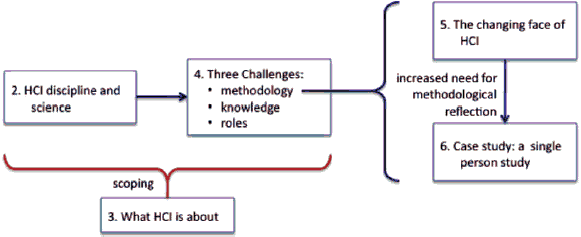


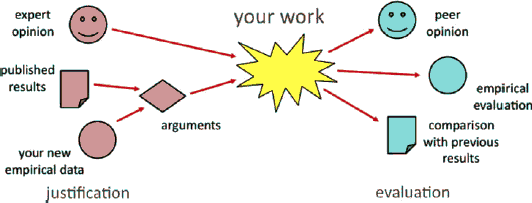
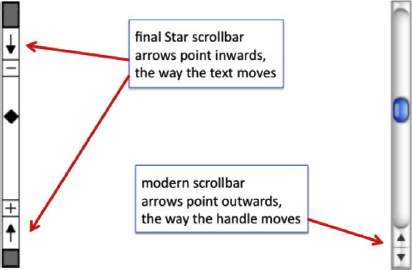
Fig. 5. Xerox Star and modern (Mac OS X) scrollbars.
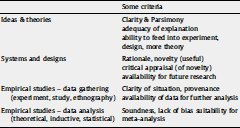
Table 1. Roles and criteria.
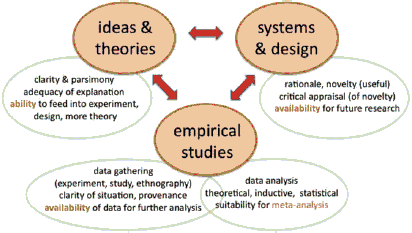
Fig. 6. Roles in HCI research

for 20 years the computer is
chained to the office desktop
(image © Matt Oppenheim)
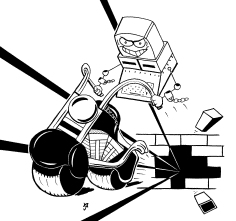
... now escapes: out into the world,
spreading across the net, in the home,
in our social lives
(image © Matt Oppenheim)
|
![]() PDF, 1.2Mb)
PDF, 1.2Mb)